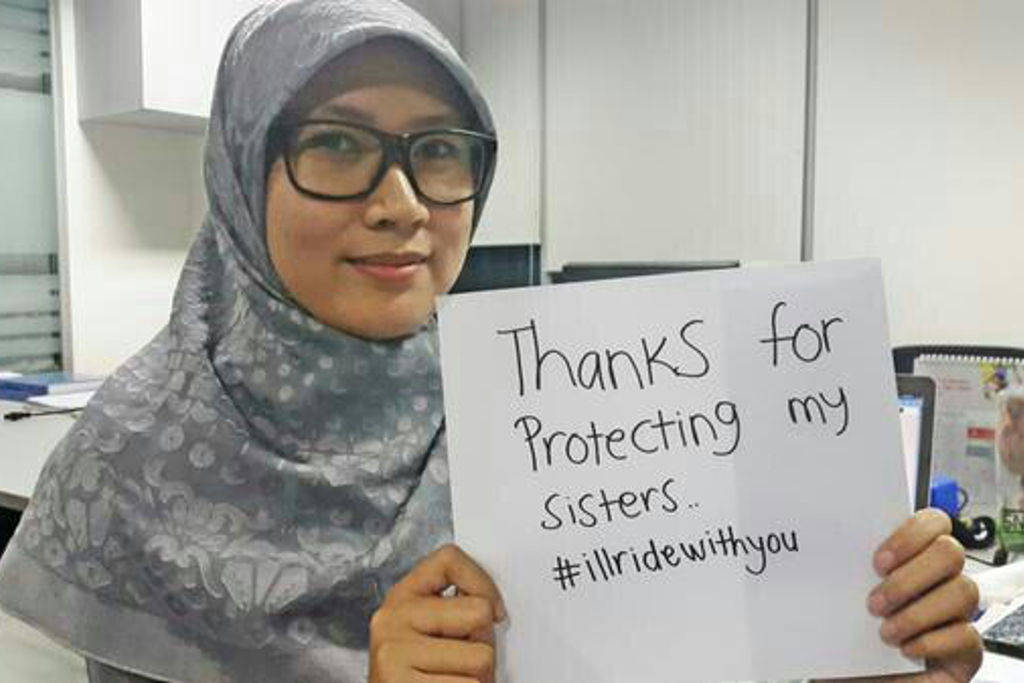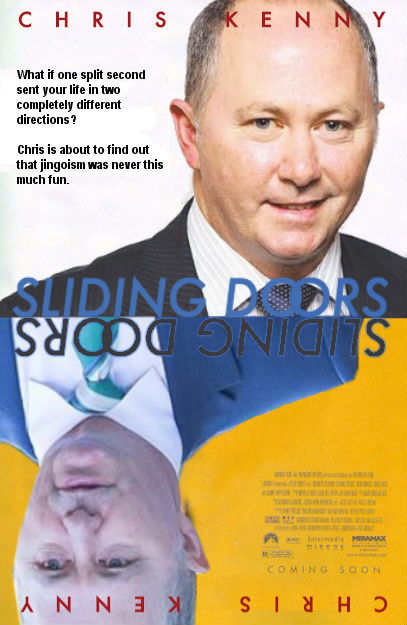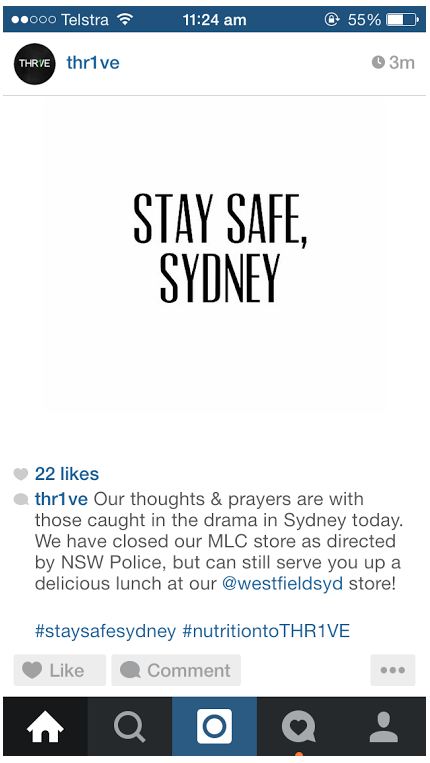How Australia Covered The Sydney Siege
From Twitter, to Buzzfeed, to the Daily Telegraph: the good, the great, and the ugly.

The Sydney siege was a crime perpetrated by an individual acting alone. It wasn’t an organised terrorist act by representatives of a political group. It was a NSW state police matter. It wasn’t a national security matter.
But you wouldn’t have known that from the breathless way it was reported and commented on.
Daily Telegraph #sydneysiege front page with comment piece “The instant we changed forever” http://t.co/pJTrm3QzZP pic.twitter.com/VgNa7BqO7U
— Nic Christensen (@nicchristensen) December 15, 2014
As Alex McKinnon wrote yesterday, the best way to contribute to public discussion on this news story is to “keep calm and don’t speculate”. But speculate wildly is just what people did. Often with misspelled hashtags. Understandably in a tragedy like this, many Australians were glued to liveblogs, social media hashtags and TV feeds. Less forgivably, some actually showed up at Martin Place to get drunk and take selfies.
Crowd gathered, stunned at what is unfolding in the heart of Sydney #MartinPlaceSeige pic.twitter.com/eM5jZf3I8W — Sarah Gerathy (@sarahgerathy) December 15, 2014
Meanwhile, here’s what else happened yesterday. The business case for Melbourne’s controversial East-West Link tollway was revealed at last… to be a complete sham. A bushfire threatened Perth’s north-east. Malcolm Turnbull inked an NBN deal with Telstra that’ll be faster, cheaper and use ye olde copper cables. Joe Hockey plans to axe 175 government agencies and counting, as the Mid-Year Economic and Fiscal Outlook (MYEFO) revealed the federal budget deficit has blown out from $29.8 billion to $40.4 billion. And Steve Smith – poor, unheralded Steve Smith – was named Australia’s Test cricket captain.
The amount of blanket rolling coverage given to the Sydney siege – last night there was nothing else on TV – suggests it was uniquely newsworthy. More significant than, say, the siege that at the time of writing was still ongoing in Altona North in Melbourne. Or the one two weeks ago in Brunswick, or in Cleveland, Brisbane.
What made the Sydney siege seem different was that many journalists, commentators and social media users filled the hours they spent waiting for the situation to resolve with a rhetoric of ‘terrorism’ that for the most part depends on Islamophobic sentiments in certain segments of the Australian population. This fear of the Other has been deliberately nurtured by the Abbott government and by the populist media, including talkback radio and the Murdoch press.
Speaking of whom: Uncle Rupert’s response to the deaths of three people was to crow that his paper got the scoop first.
AUST gets wake-call with Sydney terror. Only Daily Telegraph caught the bloody outcome at 2.00 am. Congrats.
— Rupert Murdoch (@rupertmurdoch) December 15, 2014
He truly is an appalling person.
Bearing False Witness
Irresponsible speculation has real consequences. Of the eight million-odd tweets sent by 3.7 million people after the 2013 Boston Marathon bombing, only 20% contained factual information. An IBM Research Labs study conducted in the aftermath found that, “Rumors or fake or incorrect information spread via online social media … resulted in chaos and damage to people in the real world.” Similarly, the tone – and sheer volume – of yesterday’s coverage made many people feel unnecessarily afraid and helpless. Especially Muslim Australians.
I collated what my fellow Muslim Aussies were saying on FB about #SydneySiege – basically concern for hostages & fear pic.twitter.com/obPmgDzxPh — Nasya Bahfen (@nasyabahfen) December 15, 2014
This, this is what good people do. #sydneyseige #MartinPlace pic.twitter.com/zxbHLWzxEp
— Michael James (@MichaelJames_TV) December 15, 2014
The #illridewithyou hashtag that went viral across the world both expresses a practical solidarity with Muslim Australians who may face harassment on public transport, and conveys a heartening refusal to indulge divisive rhetoric. But such a pushback response was only necessary because so many in the media were fanning the fear with ill-judged commentary.
The people in the cafe are the ones who deserve your thoughts not some imaginary fellow bus passenger. — Chris Kenny (@chriskkenny) December 15, 2014
Chris Kenny, the unlikely source of the first Tweet about the siege, embarrassed himself and The Australian with a breathless colour piece on how it could’ve been him in that café!
“My fellow customers – fellow Australians – are now in a horrific situation, the sliding doors of the cafe playing a brutal game of chance and fate in Sydney today,” Kenny wrote. “Terror is in the heart of Sydney right now.”

The Australian’s notoriously combative media editor, Sharri Markson, took some time out to wring her hands about “nastiness and aggression”.
You’d think a situation like this would bring solidarity and a sense of togetherness. Instead, people are showing nastiness and aggression.
— Sharri Markson (@SharriMarkson) December 15, 2014
@SharriMarkson You mean like the Daily Telegraph’s coverage? Sure to feature in the media section next week, no doubt :) — newmatilda (@newmatilda) December 15, 2014
Mamamia showed an equal talent for doublethink when it dissed the Daily Telegraph cover in one article, and yet published a risible open letter to “the frightened strangers” held hostage: “All of our arms are around you right now. And if we could whisper in your ear, this is what we would say: You are loved. You are loved.”
It’s a close contest, but for my money the most ill-judged story had to be News.com.au’s Anthony Sharwood interviewing randoms in nearby Hyde Park. One of them was a self-described “ukulele minstrel” whose incisive analysis of the situation was, “Get out of my beautiful day, stupid terrorists.”
Having quoted Tony Abbott’s statement that nothing will ever change the peaceful generosity of Australian society, Sharwood mused: “[Abbott] was also right, and it’s worth mentioning that he spoke with a Christmas tree behind him.” FACEPALM.
Some journalists, however, confined themselves to straight reporting. Lucy Carter, ABC’s Sydney police reporter, was at the scene, as was Buzzfeed Australia’s breaking news reporter Mark Di Stefano, who spotlighted some of the more egregious rubbernecking from 300-odd members of the general public.
The punters are back taking selfies 100m from the Lindt Cafe #sydneysiege pic.twitter.com/JoAa9JO0Ep
— Mark Di Stefano (@MarkDiStef) December 15, 2014
The Guardian’s liveblog maintained a sober tone and an emphasis on facts. Bridie Jabour staffed it during the day, when most commentary was flowing in (“The Daily Telegraph is a tabloid, so an excitable tone is to be expected”). Katharine Murphy had the thanklessly uneventful evening shift. (“Still slightly amazed about the pointless argument this evening about I’llRideWithYou. It’s just a moment, which really should be allowed just to speak for itself.”) And Claire Phipps made sense of the rapid, confusingly reported end to the siege. (“There are televised images of stretchers being moved away; I won’t publish those.”)
Lowy Institute military fellow James Brown, who has first-hand experience of ‘professional’ terror tactics, distinguished himself as yesterday’s best talking head. He correctly predicted, early on, that the siege was the work of someone acting alone. “We’ve got to be careful here that we don’t spread fear,” Brown calmly explained on ABC’s The World Today.
Waiting And Watching For Something To Happen
@ki_sekiya @jessradio @lucethoughts modern media event entails voyeurism, voyeur-shaming, and the recursive voyeurism of voyeur-watching. — David Spencer (@Honxqp) December 15, 2014
“When you are able to stand behind police tape in Martin Place, in the centre of Sydney, and watch a jihadist hostage siege unfold, you know that the War on Terror has arrived,” opined Herald Sun reporter Paul Toohey.
Nope. If media and the general public are able to stand around at their leisure, gawking at, filming and photographing a crime in progress while the rest of the city goes about its business, it’s probably not terrorism.
Two young guys have arrived and are swigging from bottles of white wine. This is a hostage situation #sydneysiege pic.twitter.com/nwGAIcqt3S
— Mark Di Stefano (@MarkDiStef) December 15, 2014
When you believe an event is truly momentous, and you’re able to watch it unfold – by hashtag, by live video feed or in person – you can feel that the act of you watching is something important, something political. And you’re tempted to commentate, not just observe: to add your voice; to accrue those righteous thumbs-up, retweets and favourites.
Both journalists and social media users showed a tremendous desire to bear witness. In most cases, this desire sprang from professionalism and goodwill rather than morbid curiosity; the I’llRideWithYou hashtag provided an outlet for that goodwill, binding Australians together in a shared polity without requiring a cathartic resolution of the siege.
Thanks for protecting my sisters #illridewithyou pic.twitter.com/Qy9l0lN1qB — Angger Prawitasari (@anggerwitasari) December 15, 2014
But because the limited events inside the café couldn’t satisfy that witnessing desire, we also watched each other. People scrolling through hashtags critiqued those watching at Martin Place. Journalists reported on journalists. Journalists reported on hashtags. Everyone became a frickin’ flag expert.
ISIS flag pushed at Lindt cafe window
— Heath Aston (@HeathJAston) December 14, 2014
Guys, guys, guys. That’s not an ISIS flag, it’s a shahada flag. pic.twitter.com/oMZm5VDXVR — Dale Roots (@dale_roots) December 14, 2014
Infographic: The flag being shown in Martin Place, as compared to the flag used by IS and others. #SydneySiege pic.twitter.com/rMMU28danL
— smh.com.au (@smh) December 15, 2014
Yeah I don’t think there’s a *good* flag you can hang in a window where you’re taking hostages. — Belf Jinglekins (@bencjenkins) December 14, 2014
“Let’s hold off and see what happens” really doesn’t feel like an option in this charged political and news climate. But too many things were posted rashly yesterday, simply because they could be, and because if they turned out to be wrong, they could always be edited or deleted on the fly. Never mind that the blanket coverage may have helped the hostage-taker, or hindered the police operation to free the hostages.
Yes, There’s Such A Thing As Bad Publicity
You didn’t have to be a journalist to be a complete nincompoop. It was like midday at Big Ben, given the number of clangers being dropped as unscrupulous or just socially inept individuals and companies sought to capitalise on the siege.
Car hailing service Uber has had quite enough bad publicity already, but the company seems to relish its complete social tone-deafness. Accordingly, it’s automatic system of supply/demand pricing saw surges of a minimum $100 out of Sydney’s CBD yesterday…
We are all concerned with events in CBD. Fares have increased to encourage more drivers to come online & pick up passengers in the area.
— Uber Sydney (@Uber_Sydney) December 15, 2014
…before outcry from users and the media saw the company back down and announce free rides.
Uber Sydney trips from CBD will be free for riders. Higher rates are still in place to encourage drivers to get into the CBD. — Uber Sydney (@Uber_Sydney) December 15, 2014
Self-proclaimed social media guru Laurel Papworth focused on what was really important: why Lindt’s social manager wasn’t all up tweeting in this shizz.
Where is the social media manager for @LindtCafeAus :( :( #MartinPlace
— Laurel Papworth (@SilkCharm) December 14, 2014
This came across as disingenuous at best – especially as she later tried to reframe her tweet as a collegial check that a fellow industry professional was okay.
I still want to know – who is the community manager for Lindt & are they ok? Read what you want into that but does anyone know? — Laurel Papworth (@SilkCharm) December 15, 2014
Meanwhile, a Sydney food store took a moment on Instagram to promote its “delicious lunch”, while some random band piggybacked on the #sydneysiege Twitter hashtag for a (now deleted) promotional tweet: “We are currently working on our new song(Clairvoyent) I really hope you will enjoy it!! Check it out”

The Australian Retailers Association was mainly annoyed that the siege interrupted the busy pre-Christmas shopping season. “I don’t want to be prophet of doom and gloom but you do worry about how this could affect spending,” the association’s chief executive Russell Zimmerman told the Sydney Morning Herald.
Today and in coming days, there’ll be much mourning, some actual answers… and a temptation to turn on each other afresh. Regrettably, Sunrise’s David Koch referred to the hostage-taker on air this morning as a “rogue refugee”.
Things that embarrass me deeply: @Channel7 Sunrise asking why a Muslim community leader didn't stop a 'rogue refugee'? #xenophobia The Law!
— Michela Ziady (@annie_nigma) December 15, 2014
@kochie_online not impressed with your extrapolation of this incident to 'rogue refugees' #sydneysiege @sunriseon7 #onecriminal
— Emma Tomkinson (@emma_tomkinson) December 15, 2014
As The Guardian’s Martin Chulov points out, the atomisation of terrorism is real. At least 90 Australians – more per capita than almost any other nation – have quietly ‘self-radicalised’ and travelled to join terrorist organisations in Syria. But on the other hand, Chulov notes, “another small and ill-defined number of citizens … have developed grievances over the past decade and are willing to hitch themselves to a terror group’s cause to settle personal scores.”
It’s precisely the uncertainty over who is involved in terrorism that means we must reject inflammatory rhetoric of “political motivation”, “ISIS flags” and “rogue refugees”, which is really about demonising religious and ethnic minorities. We need to frame the Sydney siege not as a completely new, scary kind of threat, but as a terrible yet familiar crime.
–
Mel Campbell is a freelance journalist and cultural critic. She tweets at @incrediblemelk.